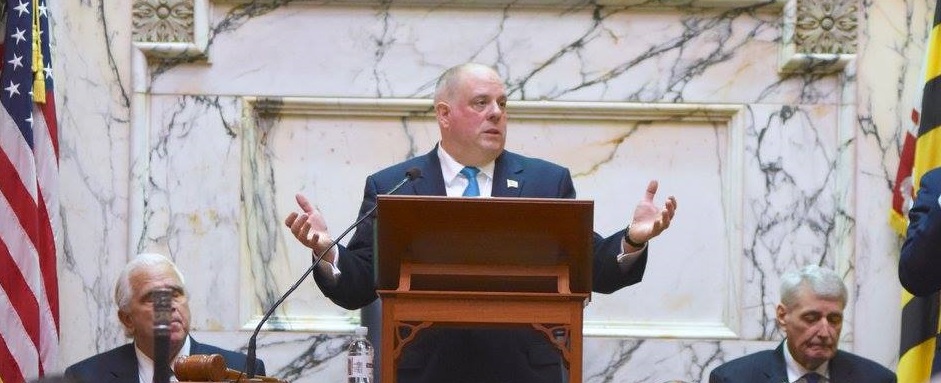Governor Hogan Announces Additional Steps to Protect Marylanders From Coronavirus
Will Include $10 Million in Emergency Funding in Supplemental Budget, Details Statewide Preparedness Efforts Underway, Encourages Marylanders to Use 2-1-1 Hotline for Questions and Concerns, Discusses Coordinated Response with Vice President Pence
ANNAPOLIS, MD—At a press conference today at the State Emergency Operations Center of the Maryland Emergency Management Agency, Governor Larry Hogan provided an update and announced additional steps the state is taking to protect Marylanders from the novel coronavirus (COVID-19) and prepare for any potential outbreak. Prior to the press conference, Governor Hogan convened a meeting with senior Cabinet officials and spoke to Vice President Mike Pence, who is leading the federal response.
“While there is currently no immediate public health emergency here in Maryland, based on the latest guidance from the CDC and our federal partners, we want our citizens to know that all levels of government are working together proactively and taking every possible precaution to respond to threats of public health,” said Governor Hogan. “We will continue to track this and will be receiving almost constant, up-to-the-minute information. The public should be assured that our state’s preparedness builds on decades of planning, experience, and expertise gained from previous and ongoing public health events. I would encourage all Marylanders not to panic, but to take this seriously and to continue to stay informed.”
Joined by senior Cabinet officials, the governor announced that he will submit a supplemental budget that will include $10 million for emergency coronavirus preparedness expenses. While there are still no confirmed cases of coronavirus in Maryland at this time, two patients have met the criteria for Centers for Disease Control and Prevention (CDC) testing. The governor stressed the importance of heeding the CDC’s guidance that local schools, businesses, and communities should be prepared for closures and disruptions to daily life.
In addition, the governor encouraged Marylanders to visit health.maryland.gov/
The governor also announced that in addition to convening his full Cabinet tomorrow, administration officials will provide a detailed briefing to members of the General Assembly, as well as the Comptroller, the Attorney General, and the Treasurer.
Statewide Preparedness Efforts Continue
In January, Governor Hogan directed all state agencies to take every precaution and mobilize whatever resources are necessary to address COVID-19. Pursuant to his direction, the Maryland Department of Health (MDH) continues to coordinate with the Maryland Emergency Management Agency (MEMA) and all state, federal, and local partners to lead response efforts, all with the goal to minimize risk to the public.
MDH is engaged in regular communications with clinicians and health care providers across the state, working with local hospitals to develop comprehensive hospital surge plans to be activated if necessary. The department’s preparedness and response team is inventorying available resources at hospitals, local health departments, federally qualified healthcare centers, long term care facilities, dialysis centers, and other healthcare partners. MDH’s infectious disease experts are providing weekly briefings to all local health departments and healthcare facilities across the state.
MDH has worked with the Maryland State Department of Education (MSDE) to provide guidance to school systems across the state, and is coordinating with colleges and universities to address concerns with student and faculty populations. In coordination with the Maryland Department of Transportation (MDOT), MDH is actively engaged with travelers to ensure they have the information they need and are following CDC guidance to protect the safety of these travelers and the public.
Potential alternative housing, support and transportation are being developed should some Marylanders impacted by the virus not be able to recover at home.
Additionally, state agencies are participating in daily briefing and coordination calls with federal partners at the CDC, the U.S. Health and Human Services Assistant Secretary for Preparedness and Response, and the Department of Defense. Frequent calls are held with neighboring states to coordinate case surveillance, investigation and response activities (including senior health officials, epidemiologists and public health emergency preparedness directors).
What can Marylanders do to prepare?
Though the public health threat here in Maryland and across the United States remains low, you can take very basic steps to help keep yourself and your loved ones healthy.
- Stay informed — Visit cdc.gov for the most recent general updates and health.maryland.gov for the latest information on COVID-19 in Maryland.
- Practice everyday actions to promote good health and prevent the spread of respiratory viruses, including COVID-19:
- Wash your hands frequently with an alcohol-based hand sanitizer or soap and water
- Cover your mouth and nose while coughing or sneezing
- Avoid close contact with people who are sick
- If you are sick, stay home from work or school
- Avoid touching your eyes, nose or mouth
- Build a preparedness kit for your home in case you are sick with any respiratory virus and need to stay at home. See health.maryland.gov for details. Examples include:
- Pain relievers, fever reducers, decongestants, and cough drops
- Alcohol–based hand sanitizer
- Thermometer
- Facial tissues, paper products
- Nonperishable food
- Extended supply of prescription medications
- Diapers or pet supplies if needed
- There is no vaccine to prevent COVID-19, but you should get a flu shot — it’s not too late. It will not prevent COVID-19, but getting a flu shot will help keep you and your loved ones healthy as we continue to see widespread flu.
Visit health.maryland.gov/

